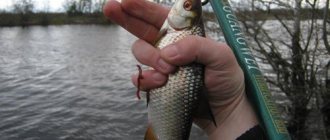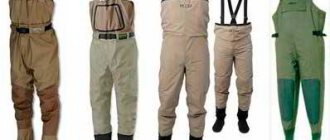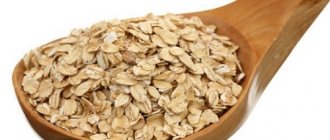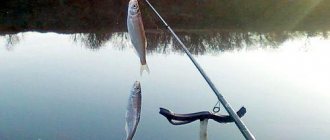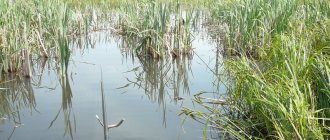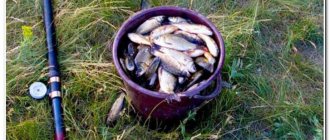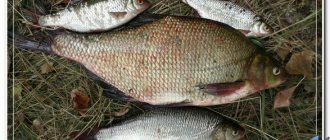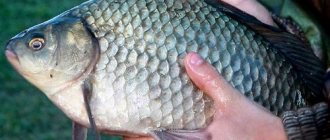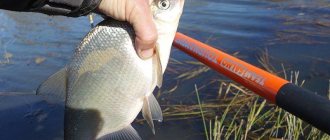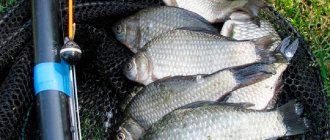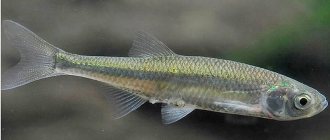Fishing places
For tench fishing in the spring to be successful, the angler must have an idea of where to look for this fish at a given time of the year. A correctly chosen place largely determines the success of fishing.
Even in summer, tench is extremely rarely found at a depth of more than 3 m. In spring, when the water temperature is quite low, this heat-loving fish prefers to feed in shallow, well-warmed areas by the sun. River representatives of this species should be looked for:
- in creeks and bays with a depth of no more than 1 m;
- on water meadows;
- in shallow water eriks.
In early spring, on ponds and lakes, tench stand in the coastal zone, preferring to feed near the wall of reeds or near last year's vegetation. As the water warms, the fish move a little further from the shore. At the end of the season, it can be found in typical summer places, which are characterized by an abundance of aquatic vegetation and depths of 1–2 m.
Tench: description and behavioral characteristics
The body is dense, more elongated upward than in length. Covered with small scales with a thick film of mucus.
Body color depends on the conditions in which the fish live. For example, those individuals that live in waters with silt at the bottom are colored brown with a bronze tint, and those that live in clean waters with sandy soil are colored green with a silver tint.
The color of the fins is gray, although the main fins are yellowish at the base. The fin on the back is decorated with 4 straight rays and 8-9 branched ones, the anal fin is decorated with 3 straight rays and 8-9 branched ones. The tail has no notch.
The difference between female and male individuals
An adult grows on average by 0.2-0.4 m, maybe 0.7 m, and weighs up to 7.5 kg.
Small antennae grow at the corners of the mouth. The eyes are small orange with a red tint. Pharyngeal teeth in one row.
Males have pronounced sexual characteristics - their pelvic fin is larger and the second ray is noticeably thicker. Puberty occurs at the age of 3-4 years.
There is also a golden type with a light color and dark eyes, which was bred decoratively.
Behavior
Spends most of his life alone. Flocks gather only when it is necessary to lay eggs and in winter.
Its main occupation is searching for food in the mud.
With the arrival of frost it becomes less active and mobile. It gathers in flocks for wintering, and therefore looks for the largest depressions and holes, where it burrows into the muddy bottom.
With the arrival of warmth, the fish feast begins. And with an increase in the temperature of the aquatic environment to 18°C, reproduction begins.
Spawning
This process begins at the end of May with the water warming to 18-20°C and ends somewhere in early July . Eggs are laid in three stages with some interval in time, when the already laid eggs mature. The eggs themselves are small and greenish in color. Preferred spawning sites are the shores of lakes, where the water is clean and the current is weak.
Egg throwing occurs at a depth of 0.5 to 1 m near underwater plants and parts of their roots. One individual measuring 0.18 m and weighing 0.2 kg can lay up to 63 thousand eggs, and one measuring 0.25 m and weighing 0.4 kg can lay up to 320 thousand. Maturation occurs in 4-7 days at a temperature of about 23° WITH.
Tench growth occurs very slowly. In 1 year it can grow to 10 g, in 2 - up to 120 g, in 3 - up to 300 g.
Nutrition
It feeds mainly on invertebrates found in the silt layer. These are insects, worms, mollusks. It can snatch food from a depth of 8-10 cm. It also consumes young shoots of some aquatic plants (reeds, reeds, sedges).
Habitats
Prefers a quiet shore where there is soft root vegetation. Lives in bodies of water with slow currents and overgrown plants. Also loves clean, fresh water. But at the same time, it can live in a body of water where there is little oxygen and no other species lives.
The main favorite places where you can find food are shallow depths with thickets and a bottom with silt.
It prefers worms, larvae, leeches, snails, nymphs, and bloodworms for food.
Although if the silt lies in a thick layer at the bottom (from 50 cm), then it is difficult to find tench in such places. This is due to the processes of decomposition in such a thickness of soil, which is why the living creatures on which this species feeds do not live.
Experienced fishermen recommend those places where water lilies or horsetail grow on the bottom with silt no thicker than 0.2 m, and also near thickets of reeds or reeds.
Swaying plants and gas bubbles on the surface of the water, which appear as a result of the fish searching for food and digging at the bottom of the reservoir, will help you find the place. His movements are slow and deliberate.
This fish is not a timid one. Looking for food, she can scour the shoreline and a thick fishing line will not scare her.
Tackle
There are special requirements for tench fishing gear. This is due to certain fishing conditions and the strong resistance that this fish provides when playing.
Float rod
For catching tench in the spring on a pond or in river creeks and eriks, a fly float rod is perfect. This gear includes:
- telescopic rod 4–6 m long;
- float with a carrying capacity of about 1 g;
- fishing line with a diameter of 0.18 mm;
- set of loads;
- hook No. 8-6.
Since fishing is often carried out among dense thickets of aquatic vegetation, it is often necessary to use forced fishing. A fairly powerful rod of medium stiffness is perfect for these purposes. It would be good if his whip, which is the most vulnerable element, was made not of carbon fiber, but of more durable fiberglass. This will slightly increase the weight of the fishing rod, but at the same time, it will add a significant margin of safety to it.
When fishing in shallow water, it is very important to use a float with a small carrying capacity. During splashdown, such equipment will create a minimum of noise, which will avoid scaring away the cautious tench. In addition, a lightweight bite alarm is more sensitive and better detects fish touching the bait.
A special feature of the rigging of a float fishing rod on a line is also the absence of a leash. The fact is that when fishing for this fish, the bottom sinker must lie on the bottom soil, and in this case the thickness of the leading line is not decisive. The absence of nodal connections gives the gear an increased margin of safety.
The weights are distributed on the line so that the main part of them is concentrated closer to the float. A pellet weighing no more than 0.3 g is placed 15 cm from the hook.
For catching tench, dark-colored hooks with a semicircular bend are better suited. They are practically invisible on muddy soil and can be used with any type of attachment.
Catching tench in the spring with a float rod is not fraught with any particular difficulties. The equipment is thrown closer to the wall of reeds or into gaps of aquatic vegetation. Since this representative of the ichthyofauna prefers to take bait lying motionless on the bottom, the float release is adjusted so that the lower sinker touches the ground. Sometimes you have to wait quite a long time for a bite, so it’s better to place the rod on spears stuck in the ground in advance.
Tench can take a very long time to savor the bait, so you should not hook at the first sign of a bite. You need to wait for the float to move sharply to the side and down.
Feeder
For spring tench fishing on a lake or reservoir, where shallow waters can have a large area, feeder gear consisting of the following elements is optimal:
- a feeder rod about 3 m long and up to 30 g of dough;
- spinning reel size 3000;
- monofilament fishing line with a diameter of 0.25 mm;
- feeder feeder weighing no more than 20 g;
- monofilament leash 0.18 mm thick;
- hook No. 8–6.
Since fishing for tench on a feeder in the spring is carried out at a relatively short distance from the shore, it would be advisable to use light picker class rods of medium action. The main requirement for the reel is fine adjustment of the friction brake, which will avoid breakage of the equipment during sudden jerks of the fish.
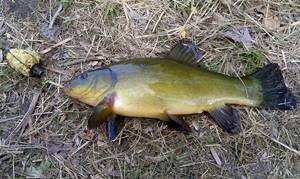
Since fishing takes place in still water and at a relatively short distance, it is better to wind monofilament fishing line onto the reel spool. Thanks to the high elongation coefficient of such a monofilament, the number of slips and breaks will be minimized.
Fishing in shallow water involves using the lightest possible feeders that make virtually no noise when splashing down. Their average weight should be about 15 g. Heavier models can only be used in conditions of strong cross winds.
The leash is knitted from high-quality monofilament fishing line. Since the line is fed from the bottom, the length of this element of the equipment should not be 20–30 cm. The same requirements are imposed on the hook as in the float equipment.
You shouldn’t re-throw the tackle too often, thereby scaring the fish that come up for bait. Having made the starting feeding, you need to be patient and wait for the tench to show interest in the bait. If within 15–20 min. there was no bite, it makes sense to change the type of nozzle.
☸ Tackle for fishing in the reeds
Fishing in the reeds is difficult even for an experienced fisherman, not to mention beginners. Therefore, it is better to give preference to a light and comfortable fly rod. With such gear, you can cast the bait with an accuracy of a few centimeters, which significantly reduces the risk of snags.
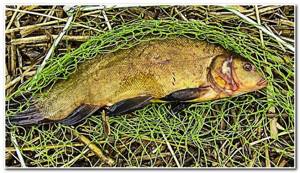
The equipment depends on the size of the line. If we are talking about medium-sized molts weighing approximately 300-400 g, then the best option would be the following set of elements:
- rod up to 5 meters;
- main line – nylon monofilament 20 mm;
- float - preferably inconspicuous (not too bright) weighing up to 2 g;
- sinker - two gram pellets plus additional 0.1-0.2 g;
- the leash is also made of monofilament, but with a smaller diameter - 0.16 mm;
- hook No. 7 or 8.
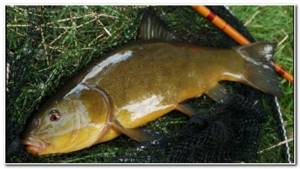
Lures
Tench are quite picky when it comes to choosing bait and can change their taste preferences several times during the day. It follows from this that you need to take different baits when fishing. The following work best in early and mid-spring:
- muckworm;
- bloodworm;
- maggot.
The dung worm is the most popular and effective bait used for spring tench fishing. For bait, it is better to use a cut worm rather than a whole one. 3-5 pieces, about 2 cm long, are attached to the hook. In this form, the bait becomes more attractive to fish, as it emits a strong aroma.
Some anglers add a little chopped garlic to the container where the worms are stored. It has been noticed that such aromatization has a positive effect on the tench bite in the spring.
Tench loves voluminous baits, so if bloodworms or maggots are used as bait, 5–7 larvae should be placed on the hook. In the spring, various combinations of animal baits are often effective:
- bloodworm + maggot;
- worm + maggot;
- bloodworm + maggot + worm.
At the end of spring, when the water temperature rises above 15 degrees, the tench switches to feeding on algae and begins to pay attention to baits of plant origin:
- semolina dough;
- canned corn;
- pellets;
- bread crumb;
- boiled pearl barley.
In warm water, when searching for food, carp fish are largely guided by their sense of smell, so it is advisable to flavor plant baits with sweet flavors.
Plant attachments
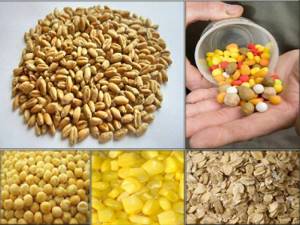
Nozzles of plant origin, frankly speaking, are somewhat inferior compared to baits of animal origin. No one wants to eat simple porridge when there is a meat dish on the table. At the same time, there are plant attachments that show decent results. What can be included here?
An ordinary bread crumb can become a bait for tench. Especially if the bread is flavored. But you should not regard the bread crumb as the main attachment. This is rather a kind of Spartan version!
But if you mix soft bread with sour cottage cheese, you get a really excellent attachment. The fact is that tench really likes sour cottage cheese. The aroma of cottage cheese attracts tench from a long distance. Its action resembles the effect of a magnet.
You can also use various grains when fishing for tench. When going for tench, take a can of canned corn with you. Surely tench will bite on such a bait. If you don’t have corn, you can replace it with peas.
You can also fish with a mastyrka. There are quite a few mastyreks on sale that are designed specifically for catching this bronze fish. But you shouldn’t follow the lead of marketers. Almost any mastyrka is suitable for catching tench, and it doesn’t matter what kind of fish is depicted on the package. Here you need to pay attention to the composition. In addition, the fisherman can not only buy a ready-made mixture, but also prepare it himself.
Recommended reading: Common ruff
In some cases, tench are also caught using boilies. A boilie is a special bait that is a ball of boiled dough. Of course, this dough contains more than just plain flour. Quite often, boilie manufacturers even keep the recipe secret. Boilies are more suitable for catching large tench using bottom tackle. A small fish simply cannot swallow a large bait.
Lure
Even in cool spring water, tench respond quite well to bait. At the beginning and middle of the season, an attractive mixture should have the following characteristics:
- finely ground;
- mild odor;
- dark color.
This bait can be easily prepared by adding a little sunflower cake to the rye breadcrumbs. When fishing in cold water, the composition must include animal components in the form of bloodworms, cut worms or maggots. The feeding activity of tench at this time is at a fairly low level, so for full-fledged fishing you will need no more than 500 g of dry mixture.
At the end of spring, tench begin to respond to typical summer baits, which are characterized by a medium degree of grinding and a pronounced sweet aroma. Light-colored compositions are likely to attract small representatives of this species. For targeted capture of large specimens, it is better to feed the selected point with dark mixtures.
Bait for catching tench
In order for the bait freely falling in the water to look most attractive to the fish, slowly sinking food particles must be constantly present in the fishing area. And even if bleaks and small perches are the first to reach the hook, their fuss around the bait will not go unnoticed; after a while the tench will also be attracted to the bait.
However, the tactic of continuously feeding fish in small doses should be used with great caution. Tench, although voracious before spawning, never forms large flocks. So there should not be too much bait.
If you feed generously, there is a chance that the fish will get enough and stop biting. In the spring, I completely abandoned the massive starting feeding and feed the fish like this: three or four balls of bait the size of an average tangerine - at the very beginning of fishing, then during the fishing process I provide constant supplementary feeding in small portions. When the lines become very active, you can switch to feeding with maggots or chopped worms. It is more convenient to serve this delicacy to fish with a small slingshot.
Lin has poor eyesight, but his sense of smell is very good. While the water is cold, tench feed exclusively on animal food. Therefore, in the spring, casters, chopped worms and live maggots must be present in the bait. All these additives emit a strong and not very pleasant odor. However, tench likes it. The fish begins to look for its source in the grass and stumbles upon a bait falling in the water column.
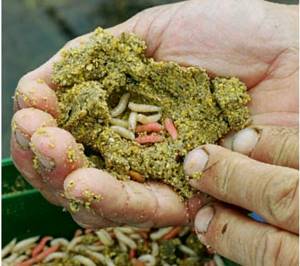
If the required amount of the above ingredients cannot be found, I add crushed snails to the prepared bait. For tench, snails are a natural delicacy, and it would be foolish not to take advantage of this weakness.
If you simply pour maggots into the bait at the very beginning of fishing, the nimble larvae will go to the bottom of the bucket and the effectiveness of the mixture will greatly decrease. I add maggots in portions: a pinch to each ball of bait. Maggots quickly destroy the shell, and a mixture of bait particles settling in the water and living, actively moving larvae ends up on the fish’s “table”.
The bait should not be heavily moistened. To create a feed column in the water, the mixture should remain slightly dry (as for feeder feeders). The main thing is that it molds into balls, and when it hits the water, such a ball breaks into pieces. To maximize the highlight of the living component, I prefer to use inexpensive base mixtures as a base.
Read! Catching perch with fry
Many tench fishing experts advise adding fresh cottage cheese to the bait. I also experimented with this additive, but I didn’t see much effect from its use, most likely due to the fact that cottage cheese makes the bait too inert. The balls fall under the carpet of grass, and the fish follow them. Judging by the air bubbles rising to the surface of the water, it is clear that there is tench in the fishing zone; it is actively feeding, but is not biting.
Weather and fishing time
In early and mid-spring, you can count on a good tench bite only in clear, windless weather. Strong winds and rain quickly lower the water temperature in shallow waters and force the fish to stop feeding and move to deeper areas.
In the first spring months, the bite begins 2–3 hours after sunrise and continues until the evening air cools. It can be extremely difficult to catch tench at dawn.
Towards the end of spring, when the water temperature reaches 15 degrees, the tench's biting pattern changes somewhat. A weak wind and light drizzle can no longer force the fish to stop feeding. The main number of bites occurs in the morning and evening hours.
Search for catchable places
In spring, you should look for tench near its spawning grounds. These are fairly shallow areas with a depth of 0.3 to 1.2 meters. Such areas of the reservoir warm up first.
In summer, tench move to deeper areas. You should now look for fish at depths of 1 to 2.5 meters. Here the fish can hide from direct sunlight among thickets of aquatic vegetation. This means that in such places there is the highest probability of seeing a bite.
In the first half of autumn, tench can be found throughout almost the entire water area of the reservoir. Now he is actively moving in search of food. But from about mid-October, tench begin to migrate to their winter resting places. During this period, it should be looked for at depths of 3 meters.
Fishing tactics and fishing
Since in spring fishing takes place in shallow water, where the fish are very shy, initially you need to feed 2 points at once, which will be convenient to fish without leaving one place. Fishing is carried out on a flat muddy bottom, so the fisherman does not have to waste time searching for edges and holes.
In early spring, starting feeding should consist of 200 g of moistened mixture. By the end of the season, this figure can be doubled.
Re-feeding of the points is carried out every 15–20 minutes. and consists of 50 g of moistened mixture. If the food activity of the fish is at a high level, supplementary feeding can be made more frequent.
If after 15 min. after casting the gear there was no bite, you need to throw the bait into another well-fed place, not forgetting to experiment with the bait.
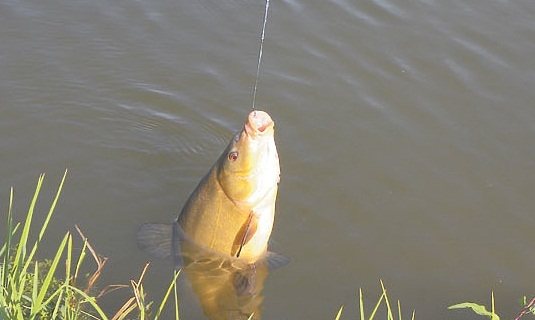
Immediately after the bite, the tench will try to move into the nearby grass. In order not to let the fish into the thick of the water thickets, you will need to point the rod in the direction opposite to its movement and, using the reliability of the gear, begin forced fishing.
When the line is 1.5–2 m from the shore, the angler must be prepared for the fact that the fish will definitely make another attempt to go into the thickets. The process of fishing will be greatly facilitated by a landing net with a long handle, thanks to which it will be possible to avoid annoying derailments that often occur at the last stage of the fight against the trophy.
Tench in spring
As soon as the ice melts on reservoirs, all species of peaceful fish that live in them become active. They actively begin to feed and gain the necessary strength for spawning. Fishermen take advantage of these features; they try to catch a worthwhile specimen, using various types of fishing.
Finding a pond with tench is now quite problematic, and even if you find the right place, it is not a guarantee that the catch will be successful. This type of fish is particularly cautious and timid towards all extraneous sounds and movements.
As the ice melts and the water warms up, the tench also begins to become more active; it leaves its wintering grounds more and more often, trying to bask in the first sun. Here he looks for food for himself, mainly small flies, worms, young vegetation at the bottom of the reservoir.
The higher the air and water temperatures, the better the tench begins to hide in plants; it is attracted by the coolness under water lilies and other plants in the pond.
Advice! Experienced fishermen advise throwing a baited hook into places where the vegetation ends and the open area begins. Tench will react almost instantly to the offered treat if done correctly.
You should not cast over long distances; you are unlikely to be able to catch the desired trophy there; fish of this species prefer to stay close to the coastline. It is important to feed the fish correctly, without this you will not see the catch. It should be understood that the process of throwing bait should be carried out carefully and as accurately as possible. At the beginning, the bait is introduced in small portions, gradually increasing the volume. Too much food will negatively affect the behavior of the fish, it will simply stop taking the bait on the hook.
How does fishing change by month?
Not all fishermen know when tench begins to bite in the spring and how its behavior changes in different months of the season. In this matter, much depends on the climatic characteristics of the region.
March
In March, you can catch tench only in the southern regions of the country, but even here its bites are extremely rare. Only towards the end of the month does the fish begin to show some stability in nutrition and, with varying success, bites on float tackle in quickly warmed up, shallow ponds and lakes.
April
In April, the tench bite in the south of the country becomes quite stable. It is successfully caught in river bays and the coastal zone of standing reservoirs. Fishing is carried out using both float and feeder tackle.
In calm, sunny weather, floaters from the middle zone manage to catch tench in the second half of April. However, large specimens are extremely rare at this time and anglers have to be content with catching specimens weighing up to 300 g.
May
May is the best time for tench fishing in the Astrakhan region. During this period, it is not uncommon to catch trophies weighing more than 3 kg. Large specimens feed 15–20 m from the shore, so feeder gear is most effective. You should arrive at the pond before sunrise. In the pre-sunset hours you can also count on a good catch.
You can successfully catch tench in May in the reservoirs of the middle zone. Peak fishing usually occurs at the end of the month. At this time, the largest individuals are more often caught at night.
Spawning period
Fishing for tench in the spring will be effective before the start of spawning; this period falls, depending on weather conditions, at the beginning or end of May. Until this period, the fish will actively feed and take, albeit with caution, its favorite delicacy. After spawning, the tench begins to “sick”, it becomes lethargic, reacts poorly to the offered bait, and practically does not feed.
After 2-3 weeks, this type of fish returns to normal and begins to actively feed and grow again. In summer, individuals will be caught in the early morning or after sunset, when the temperature drops slightly.
We found out where to catch tench with a float rod and how to do it correctly. Recommendations and tips from experienced fishermen will be useful for catching this cautious but very tasty fish.
Fishing with a float rod from the shore and from a boat
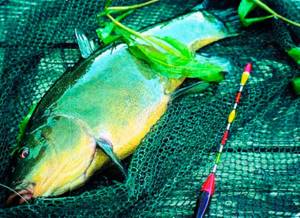
Tench, like other fish, can be caught both from the shore and from a boat. Naturally, having a boat makes fishing more effective, since it is much easier to find a fishing spot. In addition, you can change your fishing spot much faster if there is no bite. You should look for places with a muddy bottom, as well as places overgrown with reeds or reeds. If you have a boat, this problem can be solved quite quickly.
If there is no boat, you will have to use all your knowledge to find a suitable place.
